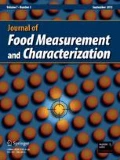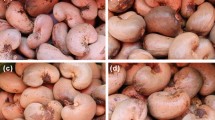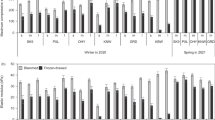Abstract
Storage of harvested agricultural products under optimum storage conditions is very important for selling them as an intended price in the market and for the maintenance of their quality longer. On the other hand, different storage techniques effects the resistance properties of products. In this research, some rupture properties like, maximum force and bioyield force, stress, maximum energy in maximum force, maximum energy in bioyield point, modulus of elasticity, bioyield deformation, maximum breaking dilatation and minimum damage height, of ‘Hayward’ kiwifruits stored under four different storage conditions (Normal Atmosphere; 21 % O2 + 0 % CO2 (NA as Control), NA storage after 1-Methylcyclopropene treatment (1-MCP + NA), NA storage with ethylene control (NA + EC), Controlled Atmosphere storage (2 % O2 + 5 % CO2) with ethylene control (CA + EC) and under two different load conditions were evaluated. Both under two load conditions rupture properties of kiwifruits stored under CA + EC conditions were measured higher than other storage conditions. In particular, maximum force and modulus of elasticity values of CA-stored kiwis were found to be statistically important.



Similar content being viewed by others
Referances
A.R. Ferguson, Kiwifruit in the world: 2014. Acta Hortic. 1096, 33–46 (2015)
FAO. FAOSTAT Database. 2012. http://faostat.fao.org/faostat/. Accessed 22 Sept 2012
C.H. Crisosto, A.A. Kader, Kiwifruit Postharvest Quality Maintenance Guidelines, vol. 95616 (Department of Pomology, University of California, Davis, 1999), p. 9
A.R. Ferguson, Kiwifruit: A Botanical Review, in Horticultural Reviews, vol. 6, ed. by J. Janick (Avi Publishing Inc, Westport, 1984), pp. 1–64
J.E. Harman, G. Hopkirk, Kiwifruit Testing For Maturity: Use of index. N.Z. Miner. Agric. Fish. Aglink HPP 213 (1982)
M.D.C. Antunes, E.M. Sfakiotakis, The effect of controlled atmosphere and ultra low oxygen on storage ability and quality of ‘Hayward’ kiwifruit.In Proceeding of the third international symposium on kiwifruit, Ed.: E. Sfakiotakis, J. Porlingis 444, 2, 613–618 (1997)
J. Burdon, N. Lallu, D. Billing, D. Burmeister, C. Yerasley, M. Wang, A. Gunson, H. Young, Carbon dioxide scrubbing systems alter the ripe fruit volatile profiles in controlled-atmosphere stored ‘Hayward’ kiwifruit. Postharvest Biol. Techol., 35, 133–141 (2005)
A.T. Öz, A. Eriş, Farklı zamanlarda derilen Hayward (Actinidia deliciosa) kivi çeşidinin kontrollü ve normal atmosfer koşullarında muhafazası. III. Bahçe Ürünlerinde Muhafaza ve Pazarlama Sempozyumu, 6–9 Eylül 2005, Mustafa Kemal Üniversitesi, Antakya–Hatay, 244–250 (2005)
I. Yildirim, ‘Hayward’ Kivi Çeşidinin Normal ve Kontrollü Atmosfer Koşullarında Depolanması Üzerine Araştırmalar (In Turkish), Doktora Tezi, Akdeniz Üniversitesi, Fen Bilimleri Enstitüsü, 159 s.(2010)
M.L. Arpaia, F.G. Mitchell, A.A. Kader, G. Mayer, Ethylene and temperature effects on softening and white core inclusions of kiwifruit stored in air or controlled atmospheres. J. Amer. Soc. Hort. Sci., 111, 149–153 (1986)
A.A. Kader, A summary of CA recommendations for fruits other than apples and pears, in 7th International Controlled Atmosphere Research Conference, University of California, Davis, July 13-18, 3, ed. by E.J. Mitcham (University of California, Davis, CA., 1997), pp. 1–34
E.C. Sisler, M, Serek, Inhibitors of ethylene responses in plants at the receptor level: recent developments. Physiol. Plant. 100, 577–582 (1997)
S.M. Blankenship, J.M. Dole, 1-Methylycyclopropene: a review. Postharvest Biol. Technol. 28, 1–25 (2003)
C.B.Watkins, W.B. Miller, Implications of 1-methylcyclopropene registration for use on horticultural products. In: Biology and Technology of the Plant Hormone Ethylene III, p 385-390 M.Vendrell, H Klee, J.C Pech, F. Romojaro, (eds.) IOS Press, Amsterdam, Netherlands.(2003)
H.O. Kim, E.W. Hewett, N. Lallu, Softening and ethylene production of kiwifruit reduced with 1-methylcyclopropene. Acta Hort. 553, 167–170 (2001)
R.L. Fisher, A.B. Benett, Role of cell wall hydrolases in fruit ripening. Annu. Rev. Plant Physiol. Plant Mol. Biol. 42, 675–703 (1991)
E.W. Hewett, H.O. Kim, N. Lallu, Postharvest Physiology of Kiwifruit: The Challenges Ahead., Proc. 4th Int. Kiwi Symp. Eds. J. Retamales et al., Acta Hort. 498, ISHS 1999, 203-214 (1999)
K. Vursavus, H. Kelebek, S. Selli, A study on some chemical and physicomechanic properties of three sweet cherry varieties (Prunus avium L.) in Turkey. J. Food Eng. 74, 568–575 (2006)
G. Sitkei, Mechanics of Agricultural Materials (Akademiai Kiad, Budapest, 1986)
A. Celik, S. Ercisli, N. Turgut, Some physical, pomological and nutritional properties of kiwifruit cv. Hayward. Int. J. Food Sci. Nutr. 58(6), 411–418 (2007)
H. Masoudi, A. Tabatabaeefar, A.M. Borghei, M. Shahbake, Investigation of mechanical properties variation of three export varieties of apples alluring the storage. M. S. Thesis, University of Tehran, Karaj, Iran. pp: 1-104 (2004)
K. Vusvarus, F. Ozgüven, Determining the Strength Properties of the Dixired Peach Variety. Turkish Journal of Agricultural and Forestry. 27, 155–160 (2003)
Y.B. Yurtlu, D. Erdoğan, Effect of Storage Time on Some Mechanical Properties and Bruise Suspectibility of Pears and apples. Turk J Agric For 29, 469–482 (2005)
L. Zhiguo, C. Thomas, Effect of Number of Locules. Loading position, and compression speed on the mechanical behaviors of tomato fruits, Int. J of Food Prop. 18(6), 1350–1358 (2015). doi:10.1080/10942912.2014.917379)
F. Kalkan, M. Kara, S. Bastaban, N. Turgut, Strength and frictional properties of Popcorn kernel as affected by moisture content. Int. J. Food Prop. 14(6), 1197–1207 (2011). doi:10.1080/1094291100363731)
B. Jaroslav, S. Nedomova, J. Trnka, J. Strnkova, Behaviour of japanese quail eggs under mechanical compression. Int. J. of Food Prop. 18(5), 1110–1118 (2015). doi:10.1080/10942912.2013.862634
H. Zareiforoush, M.H. Komarizadeh, M.R. Alizadeh, H. Tavakoli, M. Masoumi, Effects of moisture content, loading rate, and grain orientation on fracture resistance of paddy (Oryza Sativa L.) Grain. Int. J. Food Prop. 15(1), 89–98 (2012). doi:10.1080/10942911003754643)
N.N. Mohsenin, Physical Properties of Plant and Animal Materials (Gordon and Breach Science Publishing Co., New York, 1970), pp. 78–97
ASAE S368.4, Compression test of food materials of convex shape (American Society of Agricultural Engineers, St. Joseph, 2001)
Y. Chen, J.L. Gratton, J. Liu, Power requirements of hemp cutting and conditioning. Biosys. Eng. 87(4), 417–424 (2004)
O. Kabas, H.K. Celik, A. Ozmerzi, İ. Akinci, Drop test simulation of a sample tomato with finite element method. J. Sci. Food Agric. 88, 1537–1541 (2008). doi:10.1002/jsfa.3246
M.N. Galedar, A. Tabatabaeefar, A. Jafari, A. Sharifi, S. Rafiee, Bending and shearing characteristic of Alfalfa stems. Agric. Eng. Int.: CIGR EJ. vol. X (2008)
A. Ince, S. Uğurluay, E. Güzel, M.T. Özcan, Bending and shearing characteristic of sunflower stalk residue. Biosys. Eng. 92(2), 175–181 (2005)
G.C. Braga, S.M. Couto, T. Hara, J.T.P. Neto, Mechanical behaviour of macadamia nut under compression loading. J. Agric. Eng. Res. 72, 239–245 (1999)
B.C. Horsfield, R.B. Fridley, L.L. Claypool, Application of theory of elasticity to the design of fruit harvesting and handling equipment for minimum bruising. Trans. Am. Soc. Agric. Eng. 15, 746–750 (1972)
S. Calisir, T. Marakoglu, H. Ogut, O. Ozturk, Physical properties of rapeseed (Brassica napus oleifera L.). J. Food Eng. 69, 61–66 (2005)
H. Haciseferoglu, M. Ozcan, M.H. Sonmete, O. Ozbek, Some physical and chemical parameters of wild medlar (Mespilus germanica L.). J. Food Eng. 69, 1–7 (2005)
O. Ozbek, A.Y. Seflek, K. Carman, Some mechanical properties of safflower stalk. Appl. Eng. Agric. 25, 619–625 (2009)
Author information
Authors and Affiliations
Corresponding author
Rights and permissions
About this article
Cite this article
Yilmaz, D., Yildirim, I. Effects of different storage techniques on rupture properties of kiwifruits. Food Measure 10, 539–545 (2016). https://doi.org/10.1007/s11694-016-9333-0
Received:
Accepted:
Published:
Issue Date:
DOI: https://doi.org/10.1007/s11694-016-9333-0




